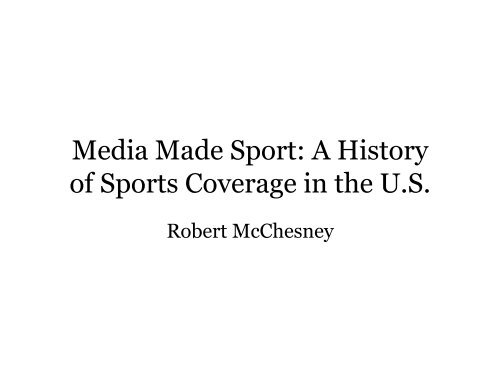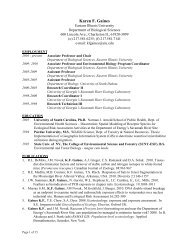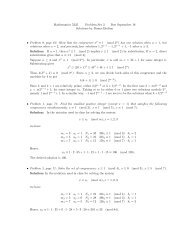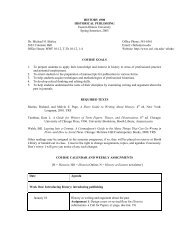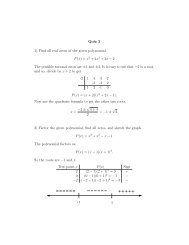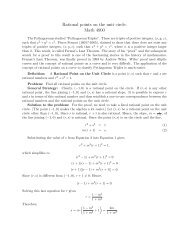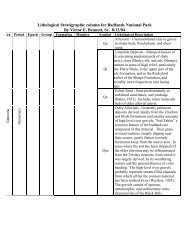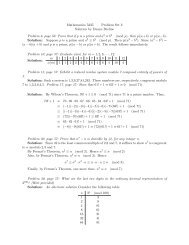Media Made Sport: A History of Sports Coverage in the U.S.
Media Made Sport: A History of Sports Coverage in the U.S.
Media Made Sport: A History of Sports Coverage in the U.S.
- TAGS
- history
- sports
- coverage
- ux1.eiu.edu
You also want an ePaper? Increase the reach of your titles
YUMPU automatically turns print PDFs into web optimized ePapers that Google loves.
<strong>Media</strong> <strong>Made</strong> <strong>Sport</strong>: A <strong>History</strong><br />
<strong>of</strong> <strong>Sport</strong>s <strong>Coverage</strong> <strong>in</strong> <strong>the</strong> U.S.<br />
Robert McChesney
Symbiotic relationship<br />
• Mass media & sports have a symbiotic<br />
relationship, rely<strong>in</strong>g on one ano<strong>the</strong>r.<br />
Capitalism drives it all, says<br />
McChesney.<br />
• <strong>Sport</strong>s – benefit from ‘enormous’<br />
attention.<br />
• <strong>Media</strong> – benefit from sales (circulation<br />
and advertis<strong>in</strong>g) by cover<strong>in</strong>g sports.
“The nature <strong>of</strong> <strong>the</strong> sport-mass media relationship<br />
has been dist<strong>in</strong>ctly shaped by <strong>the</strong> merg<strong>in</strong>g contours<br />
<strong>of</strong> American capitalism s<strong>in</strong>ce <strong>the</strong> 1830s. On one<br />
hand, much <strong>of</strong> sport and virtually all <strong>of</strong> <strong>the</strong> mass<br />
media have been organized as commercial<br />
enterprises throughout this history. Many <strong>of</strong> <strong>the</strong><br />
specific developments <strong>in</strong> <strong>the</strong> sport-mass media<br />
relationship can be fathomed only through <strong>the</strong><br />
cont<strong>in</strong>ual recognition that each <strong>of</strong> <strong>the</strong>se <strong>in</strong>stitutions<br />
has been constituted <strong>of</strong> <strong>in</strong>dividual units first and<br />
foremost striv<strong>in</strong>g for economic pr<strong>of</strong>it <strong>in</strong> some level<br />
<strong>of</strong> competition with each o<strong>the</strong>r. On <strong>the</strong> o<strong>the</strong>r hand,<br />
sport emerges as an <strong>in</strong>stitution especially well<br />
suited culturally and ideologically, first, to <strong>the</strong><br />
emerg<strong>in</strong>g capitalism <strong>of</strong> <strong>the</strong> century, and, second,<br />
– <strong>in</strong>deed, far more so– to <strong>the</strong> mature corporate<br />
capitalistic society <strong>of</strong> <strong>the</strong> twentieth century.” (pp. 49-50)
Symbiotic<br />
• “Virtually every surge <strong>in</strong> <strong>the</strong> popularity <strong>of</strong><br />
sports has been accompanied by a dramatic<br />
<strong>in</strong>crease <strong>in</strong> <strong>the</strong> coverage provided by <strong>the</strong><br />
media.” (p. 49)<br />
• And each surge was <strong>the</strong> result <strong>of</strong> <strong>in</strong>creased<br />
penetration <strong>of</strong> media<br />
• Capitalism drives success (and relationship)<br />
between sports & <strong>the</strong> media. Both sides are<br />
striv<strong>in</strong>g for economic pr<strong>of</strong>its.
<strong>Sport</strong>s well-suited to U.S. capitalism<br />
• <strong>Sport</strong>s were well-suited culturally and<br />
ideologically to <strong>the</strong> emerg<strong>in</strong>g capitalistic<br />
structure <strong>of</strong> 19th century America.<br />
• <strong>Sport</strong> also work well with ‘mature<br />
corporate capitalist’ society <strong>of</strong> 20th<br />
century.
<strong>Media</strong> history (pre-1830s)<br />
• Most newspapers and magaz<strong>in</strong>es were published for<br />
small, wealthy audiences<br />
• Literacy rates gradually <strong>in</strong>creased between<br />
1770s-1830<br />
• 1800-1830 – sharp <strong>in</strong>crease <strong>in</strong> magaz<strong>in</strong>e publish<strong>in</strong>g<br />
(several hundred new mags started)<br />
• Mags (and newspapers) not usually pr<strong>of</strong>itable at <strong>the</strong><br />
time<br />
• Most mags l<strong>in</strong>ked to o<strong>the</strong>r pr<strong>of</strong>essions & <strong>in</strong>terests<br />
(<strong>of</strong>ten, political <strong>in</strong>terests)<br />
• Publishers are also usually editors, managers and<br />
primary authors
Early American sports magaz<strong>in</strong>es<br />
• 1st American sports magaz<strong>in</strong>e <strong>in</strong> <strong>the</strong> late 1820s. By<br />
1835, seven more emerged. Only 2 would survive to<br />
1835.<br />
• Dom<strong>in</strong>ant sports pubs – American Farmer &<br />
American Turf Register<br />
• At this time, sports considered vulgar and<br />
disreputable among more literate people. So more<br />
respectable sports, like horse rac<strong>in</strong>g. Box<strong>in</strong>g received<br />
less coverage b/c it appealed to lower classes.<br />
• Writers used pseudonyms to protect <strong>the</strong>ir real<br />
identities, <strong>the</strong>ir reputations.
1830s-40s<br />
• Dramatic social change<br />
• 1st wave <strong>of</strong> <strong>in</strong>dustrialization <strong>in</strong> Nor<strong>the</strong>ast<br />
• Cities swelled (from countryside & immigrants)<br />
• Read<strong>in</strong>g public expanded<br />
• Interest <strong>in</strong> sports expanded<br />
• Spirit <strong>of</strong> <strong>the</strong> Times expanded circulation to 100,000<br />
by 1850s. Mag covered box<strong>in</strong>g and worked to<br />
establish cricket as national game. When that failed,<br />
he sought to establish baseball as national game <strong>in</strong><br />
1850s. He helped establish rules and term<strong>in</strong>ology for<br />
baseball.
1830s-40s<br />
• Birth <strong>of</strong> modern newspapers. Journalism not yet a real<br />
pr<strong>of</strong>ession at this time. Modern <strong>in</strong> that advertis<strong>in</strong>g played big<br />
part <strong>in</strong> pr<strong>of</strong>its.<br />
• Decreased pr<strong>in</strong>t<strong>in</strong>g costs, expand<strong>in</strong>g market.<br />
• Penny press emerged, as a result. Aimed at work<strong>in</strong>g class and<br />
middle-class.<br />
• Papers started to cover sports (box<strong>in</strong>g, horse rac<strong>in</strong>g and trott<strong>in</strong>g<br />
races). Publishers, though, are not sure if sports are respectable<br />
enough to cover on its pages. <strong>Coverage</strong> is sporadic, seasonal and<br />
regional. Mostly horse rac<strong>in</strong>g and box<strong>in</strong>g.<br />
• Sensationalism use to sell papers. <strong>Coverage</strong> m<strong>in</strong>or, though.
1840s-70s<br />
• Civil War helped <strong>in</strong>troduce baseball, which emerged<br />
as pre-em<strong>in</strong>ent sport. By 1869, first pro baseball<br />
league established.<br />
• <strong>Media</strong> coverage <strong>in</strong>creased. Boxscores and o<strong>the</strong>r<br />
baseball stats created by journalists. Papers asserted<br />
health benefits <strong>of</strong> athletics.<br />
• <strong>Media</strong>’s tone changed – started to promote athletics<br />
as way to tra<strong>in</strong> for life. Extoled virtues <strong>of</strong> sport for<br />
American society.<br />
• Press worked to legitimize sports as a cultural<br />
<strong>in</strong>stitution. This underm<strong>in</strong>ed <strong>the</strong> Puritan legacy (<strong>of</strong><br />
hostility) toward sports.
1880s-90s<br />
• Newspapers replaced magaz<strong>in</strong>es as primary medium.<br />
• Mags grew to 48 by 1890s. Police Gazette circulated 150,000 by<br />
1880s. Spiked to 400,000 for some issues.<br />
• But newspaper circulation grew even quicker. Reasons:<br />
technology reduced cost <strong>of</strong> pr<strong>in</strong>t<strong>in</strong>g, city populations grew,<br />
expand<strong>in</strong>g bus<strong>in</strong>esses needed way to reach customers. Ads<br />
accounted for 1/2 <strong>of</strong> newspaper revenue.<br />
• <strong>Sport</strong>s could attract readers – and, thus, potential customers<br />
– for advertisers.<br />
• In 1883, Pulitzer created 1st sports department for NY World.<br />
• In 1895, Hearst started 1st sports section at NY Journal.<br />
• <strong>Sport</strong>s journalism emerged as dist<strong>in</strong>ct genre.<br />
• <strong>Media</strong> advancements: Telegraph allowed for more timely sports<br />
<strong>in</strong>fo from all over <strong>the</strong> country.
1880s-90s cont’d<br />
• <strong>Sport</strong>s departments and regular sports sections<br />
enhanced <strong>in</strong>terest <strong>in</strong> sport. readers did not have to<br />
attend sports – or participate – to enjoy sports.<br />
<strong>Sport</strong>s-media symbiotic relationship crystallizes.<br />
• The newly formed baseball writers association<br />
recognized this <strong>in</strong> 1887, writ<strong>in</strong>g: “All sides now<br />
recognize that <strong>the</strong>ir <strong>in</strong>terests are identical. The<br />
reporters have found <strong>in</strong> <strong>the</strong> game a th<strong>in</strong>g <strong>of</strong> beauty<br />
and a source <strong>of</strong> actual employment. The game has<br />
found <strong>in</strong> <strong>the</strong> reporters its best ally and most powerful<br />
supporter.
1900-18<br />
• <strong>Sport</strong>s consolidated position<br />
• By 1910, virtually every paper gave prom<strong>in</strong>ent<br />
play to major sport<strong>in</strong>g events.<br />
• World Series started <strong>in</strong> 1903 (<strong>the</strong> last time <strong>the</strong><br />
Cubs won <strong>the</strong> Series? :)<br />
• <strong>Sport</strong>s popularized among WWI soldiers
1920s<br />
• Golden Age <strong>of</strong> <strong>Sport</strong>s<br />
• <strong>Sport</strong>s emerged as primary source <strong>of</strong> enterta<strong>in</strong>ment –<br />
thanks, perhaps, to <strong>in</strong>creased coverage and to what<br />
may have also been <strong>the</strong> Golden Age <strong>of</strong> <strong>Sport</strong>writ<strong>in</strong>g<br />
• Corporate capitalism established as political power<br />
• Newspapers decl<strong>in</strong>ed but circulation grew by 25%<br />
• Corporate capitalism elevated advertis<strong>in</strong>g to primary<br />
mode <strong>of</strong> competition<br />
• Ads <strong>in</strong>creased to 75% <strong>of</strong> newspaper revenues. Fuled<br />
<strong>the</strong> newspaper boom <strong>of</strong> ’20s.
1920s –newspaper trends<br />
3 dom<strong>in</strong>ant editorial trends emerged<br />
• No. 1 – papers decreased hard news coverage<br />
and, <strong>in</strong>stead, emphasized escapist and<br />
sensational stories to attract more readers.<br />
<strong>Sport</strong>s fit <strong>in</strong>to this idea perfectly.<br />
• 25% <strong>of</strong> all newspapers sold b/c <strong>of</strong> sports<br />
sections.
1920s – newspaper trends<br />
3 dom<strong>in</strong>ant editorial trends emerged<br />
• No. 2 – Papers standardized presentation to reduce<br />
costs.<br />
• Wire services started. Syndicated material cheaper to<br />
run than staff copy. 1920s AP started sports dept.<br />
• Press agents wrote copy for free, but this was really<br />
PR. As much as 50-60% <strong>of</strong> all stories may have been<br />
generated by <strong>the</strong>se press agents.<br />
• <strong>Sport</strong>s promoters paid expenses to ga<strong>in</strong> coverage – or<br />
even made pay<strong>of</strong>fs for coverage.
1920s – newspaper trends<br />
3 dom<strong>in</strong>ant editorial trends emerged<br />
• No. 3 – deemphasized strident political<br />
partisanship. Did not want to <strong>of</strong>fend<br />
people based upon <strong>the</strong>ir political views.<br />
<strong>Sport</strong>s was ‘safe’ ideologically. Did not<br />
antagonize. <strong>Sport</strong>s led to civic<br />
boosterism as well.
Increased coverage <strong>in</strong> ’20s<br />
• In 1880 – .04% <strong>of</strong> all editorial content addressed sports.<br />
• In 1900 – 4%<br />
• 1920s – 12 to 20%<br />
• <strong>Coverage</strong> was typically colorful and excitement. Created<br />
romance between sports and <strong>the</strong> public.<br />
• Writers – Grantland Rice, Paul Gallico, Damon Runyon.<br />
Cliché-ridden.<br />
• Writers tended to glorify sport heroes, present<strong>in</strong>g <strong>the</strong>m as<br />
larger than life.<br />
• Newspapers promoted sports
Radio<br />
• Radio contributed to popularity <strong>of</strong> college<br />
football.<br />
• But MLB owners thought it would kill<br />
attendance. Teams hired own broadcasters,<br />
soon called ‘homers.’ radio <strong>in</strong>creased<br />
attendance.
TV (1940s-50s)<br />
• Box<strong>in</strong>g perfect for TV but killed local clubs.<br />
• 300 clubs <strong>in</strong> 1952 but only 50 by 1960.<br />
• Pro boxers decl<strong>in</strong>ed by 50% as a result.<br />
• Sluggers more popular on TV so promoters developed<br />
that style more. Affected <strong>the</strong> sport.<br />
• NCAA and MLB at 1st decl<strong>in</strong>ed but <strong>the</strong>n saw f<strong>in</strong>ancial<br />
benefits; plus, TVs became a mass medium across<br />
U.S.
TV (late ‘50s to 60s)<br />
• TV penetration <strong>in</strong>creased<br />
• Technology allowed for color<strong>in</strong>stant-replay<br />
• <strong>Sport</strong>s Broadcast<strong>in</strong>g Act (1961) enabled leagues to negotiate as<br />
one<br />
• Networks purchased broadcast rights directly from teams, <strong>the</strong>n<br />
sold time to advertisers who liked access to blue-collar market.<br />
(Same reason golf is attractive for o<strong>the</strong>r advertisers today<br />
despite lower rat<strong>in</strong>gs.)<br />
• NFL leaped <strong>in</strong>to TV and even created ‘TV timeouts.’<br />
• Wide World <strong>of</strong> <strong>Sport</strong>s created <strong>in</strong> 1961
TV (‘70s-80s)<br />
• Monday Night Football created<br />
• <strong>Sport</strong>s <strong>in</strong>creased on networks <strong>in</strong> 1970s fro 787 hours to 1,356.<br />
• By 1984, annual hours at 1,700.<br />
• Advertisers loved because could reach 18-49 males, a tough to<br />
reach demographic. (6 times as many watched NFL than <strong>the</strong><br />
top show, Dallas, <strong>in</strong> 1981.)<br />
• By mid-80s, networks sell<strong>in</strong>g $1 billion <strong>in</strong> advertis<strong>in</strong>g<br />
• TV affected pr<strong>in</strong>t journalism. Less words spent describ<strong>in</strong>g action<br />
<strong>in</strong> games. Instead, analysis, background and stats emphasized.<br />
More quotes used.<br />
• The symbiotic relationship between spors and <strong>the</strong> various media<br />
cont<strong>in</strong>ues to change.


